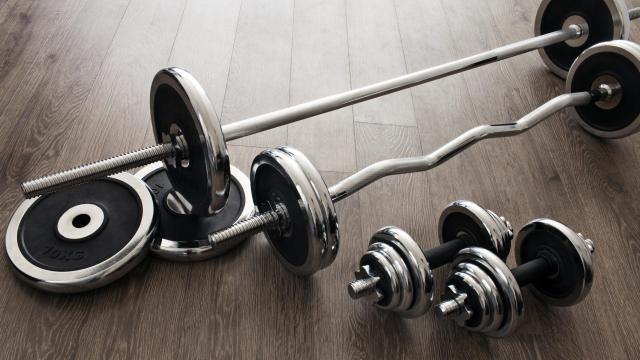Dumbbells and barbells, the two workhorses of free weight training, each have subtly different advantages. Dumbbells are small; you hold one in each hand. A barbell is the longer, typically two-handed implement. Many exercises can be done with either one. So how do you choose?
Barbells let you load more total weight
First, let’s look at a barbell’s biggest advantage: their size. Some exercises can be done just as well with either type of implement, but when you want to lift something really heavy, you pretty much have to use a barbell.
Let’s use deadlifts for an example. Beginners might be able to use heavy dumbbells for their deadlifts, but even a well-stocked gym won’t usually have dumbbells that go much above 45 kg each. That’s 91 kg total, which is only a beginner-level deadlift. And to set up for a 45 kg-per-hand dumbbell lift, you’d have to somehow get two 45 kg dumbbells off the rack. That’s going to be a heavy lift, both literally and metaphorically.
Meanwhile, a barbell weighs 20 kg, and it’s relatively easy to load 20 kg plates onto it. Setting up for a 102 kg deadlift (two plates on each side) is an easy job once you know how to do it.
Same idea with squats: It’s no problem to load up a few hundred pounds on a barbell in a squat rack, but you’d have a real hard time holding massive dumbbells on your shoulders, even if you could figure out how to get them there. There are ways to squat with smaller dumbbells (goblet squats are a lot harder than they look), but for sheer weight on the bar, you need, well, a bar.
Dumbbells can be more comfortable
Barbells require your hands to be in a certain position. You can choose how far apart to put your hands, but that’s it; they’re in those spots on the bar for the whole lift, and they have to be lined up with each other.
Dumbbells are far more forgiving. You can do a bench press, for example, while angling the dumbbells toward each other. You can also hold them farther apart at the bottom of the movement and bring them together at the top. If you have an old shoulder injury that bugs you when you do presses with a barbell, you may have an easier time with dumbbells. Similarly, a straight bar can be uncomfortable for curls, but dumbbells are an easy alternative if you don’t have an EZ-curl bar (the wiggly kind).
Dumbbells have a smaller minimum weight
If you’re a smaller or less experienced person, you may find that an empty Olympic barbell is too heavy to work with. A lot of beginners can’t overhead press a 20 kg bar at all. But a pair of 2 kg or even 5 kg dumbbells are no problem at all, since they add up to 10 or 9 kg, respectively.
Even if your goal is to do barbell lifts, starting with dumbbells can let you build up the strength to get there.
Barbells allow finer control over weight increases
Even though dumbbells have a smaller minimum weight, the jump from one weight to the next can seem huge. If you’re benching with a pair of 23 kg dumbbells (100 total), the next size up is probably 55 pounds (50 kg total), a 10% increase.
Smaller jumps, between 2% and 5%, are often more advisable. If you benched 45 kg on a barbell last week, you could throw on a pair of 1 kg plates and bench 105 this week, or even use a pair of microplates and go for 102.5. With dumbbells, you’ll need to stick with the lower weight for longer before it’s time to move up. That’s not the end of the world, but it can be inconvenient.
Dumbbells require less space in a home gym
What if you want to buy your own set of weights for home? Dumbbells have a big advantage here, since an Olympic sized barbell is seven freaking feet long. (There are smaller barbells made for home gyms, but they are often impossible to load very heavy, taking away one of the main advantages of a barbell.)
A pair of dumbbells barely takes up any space, either for storage or while in use. The downside there is that you’ll want different weights of dumbbell for different exercises (and to progress as you get stronger in each exercise), so then you either need several sets, or an adjustable set. Adjustables that let you change the weight quickly (like Powerblocks) are expensive; ones that have spin-lock collars are cheaper but you’ll spend more time between exercises changing plates.
So what’s the bottom line? If you want to compete in a barbell sport like powerlifting, or if you have your heart set on lifting really heavy, you’ll probably use barbells for most of your training. But if you want to work with smaller weights, and if space is at a premium, you’ll probably gravitate to dumbbells. At the end of the day, there’s no clear winner between dumbbells and barbells, and that’s why so many gyms have both.

Leave a Reply
You must be logged in to post a comment.